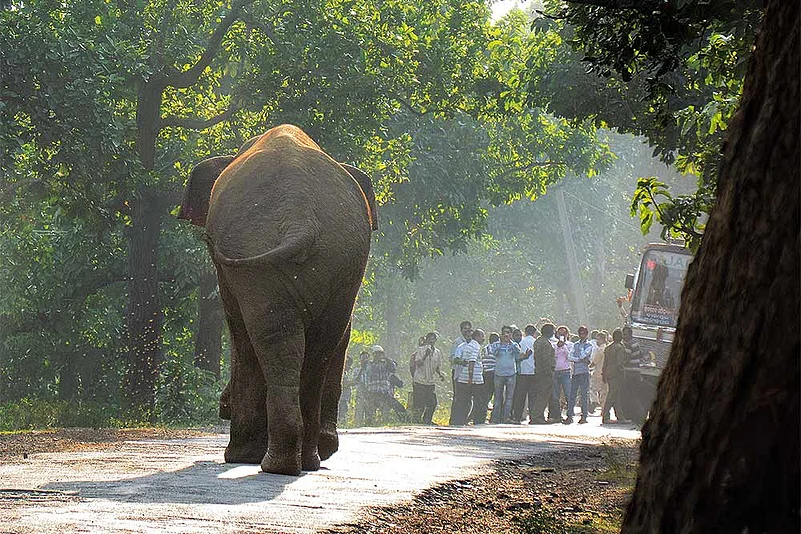Early morning on April 10, at around 6 AM, Daitari Sahu (52), a water pump operator from Baulapur village in Odisha’s Dhenkanal district, was cycling his way to the bank of river Brahmani to run the pump when he came dangerously close to a herd of nine elephants. A panic-stricken Daitari left his cycle and ran for his life. But he did not stand a chance against a rampaging tusker in the herd that chased him down and trampled him. On being discovered by locals, he was rushed to the SCB Medical College in Cuttack, but he succumbed to his injuries at around 2 PM.
More than a month after Daitari’s death, his family is yet to get over the shock of losing its sole bread earner. His wife, two daughters, Rosalin (17) and Lizarani (15), and son Ratikanta (20), stare at an uncertain future. “The man who looked after the family is now gone. It is now up to God,” says Daitari’s despondent wife, pointing to a sewing machine in one corner of the ramshackle house with which her husband used to supplement his meagre income of Rs 1, 600 as a pump operator. All that she has got by way of compensation so far is Rs 40,000.
Last year, Sabita Sahu of Sogara village, also in Dhenkanal, had her spinal cord damaged in multiple places and her hand severely injured in another early morning elephant attack. She was plucking flowers in her own backyard! After being initially treated in a government facility, she had to be shifted to a private hospital. She has already run up a bill of about Rs 7 lakh on her treatment, but received only Rs 5, 000 as compensation. She’s now trying to acquire a disability certificate that would enable her to avail a compensation of Rs 1 lakh earmarked for injuries of a permanent nature. The process of getting compensation is so cumbersome that most people give up midway.
Man-elephant conflict has shot up in Dhenkanal over the years. While locals live under constant fear of elephant encounters—not just attacks but the large-scale destruction of property and agriculture by raiding herds—elephants, left with little option but to encroach on human habitations due to man-made pressures, are under threat too. Reports pin the number of deaths of elephants and humans at 55 and 69 respectively since 2014 in the district alone. In addition, 71 humans have been injured in elephant encounters in the last five years in Dhenkanal.
The district has seen a phenomenal rise in the number of elephants, which rose from just 81 in 2002 to 169 in 2017. The number increases further during the crop season when elephants come raiding in search of food from other areas.
Biswajit Mohanty of the Wildlife Society of Odisha (WSO), the organisation monitoring man-elephant conflict in the state, attributes the unusual rise in elephant number in Dhenkanal to two things: the Rengali dam and the stone quarries. “Elephants from Keonjhar have been coming to this side for ages. Some of these elephants could not return after the construction of canals for the Rengali dam project,” he says. “Hemmed in by the dry canals on one side and the mushrooming stone quarries on the other, they have no choice but to raid nearby villages, especially those on the banks of Brahmani, in search of food and water.”
Dhenkanal is a major example of a conflict, which is worsening across India. Odisha has seen an alarming rise in casualties on both sides—humans and elephants—over the years. Figures compiled by the WSO show that about 1,400 elephants and 1,200 humans have been killed in the state due to the conflict since 1990. The last eight years have been particularly bad—leaving 591 elephants and 569 humans dead. The average annual elephant casualty, which stood at just 33 in 1990 and rose to 46 in 2000, has now reached a whopping 73, one of the highest in the country.
Poaching—by weapons, poisoning or electrocution—is easily the biggest killer of elephants in the country while electrocution, both accidental and deliberate, accounted for 165 deaths in the last 17 years. Next in the list of elephant killers are speeding trains. Though there is a system in place for advance warning about movement of elephant herds to railway authorities, it does not function properly. On April 16 this year, four elephants were crushed to death by a speeding train at the Teladihi level crossing in Odisha’s Jharsuguda district. Typically, the Forest department laid the blame on railway authorities who, in turn, said they had no prior information on the movement of elephants. There are reports of elephant casualties in road accidents too. However, they are relatively lower partly because of the provision of elephant passages. The system of blocking roads while elephants cross functions more efficiently than the monitoring of elephant movements across railway tracks.
Karnataka too has an annual elephant casualty figure of 72, but then, it has thrice the number of elephants (6049) than Odisha (1976) has. Odisha stands out in not being able to do enough about the problem. If Karnataka has used radio collaring to track tuskers to great effect, Bengal has successfully put in place a system whereby people in conflict zones are forewarned about the movement of elephants through SMS messages. Assam is using humming and stinking bees to keep elephants away from tracks. None of these measures have been attempted in Odisha. While the state has done extensive solar fencing to keep elephants in the forests, they only work in a few places. Going dangerously old school, state authorities have formed ‘elephant squads’ of local youths whose primary job is to drive elephants away when they stray into human habitations. But this is in no way a substitute for effective methods. Wildlife activists say what conflict zones really need are elephant trackers to monitor their movement and provide timely information about it to the forest department.
There is a general apathy among concerned authorities around the conflict, which is worsening with time. The attitude is to treat elephant-related incidents as natural calamities, which they are clearly not. Efforts to get a quote from Principal Chief Conservator of Forests (Wildlife), Sandeep Tripathy, were futile and Forest and Environment minister Bijayshree Routray excused himself too, saying he didn’t have the ‘details’.
Among the obvious reasons for elephants straying into human habitations in the country is the shortage of fodder due to large scale felling of trees for timber and forest fires. In Odisha, the rampant harvesting of fruits in the summer and the cutting off fodder creepers like Siali in the natural forests add to the fodder shortage. A proposal to declare 14 natural elephant corridors as eco-sensitive zones is hanging for years, allegedly, under pressure from the mining lobby.
By Sandeep Sahu in Dhenkanal


























